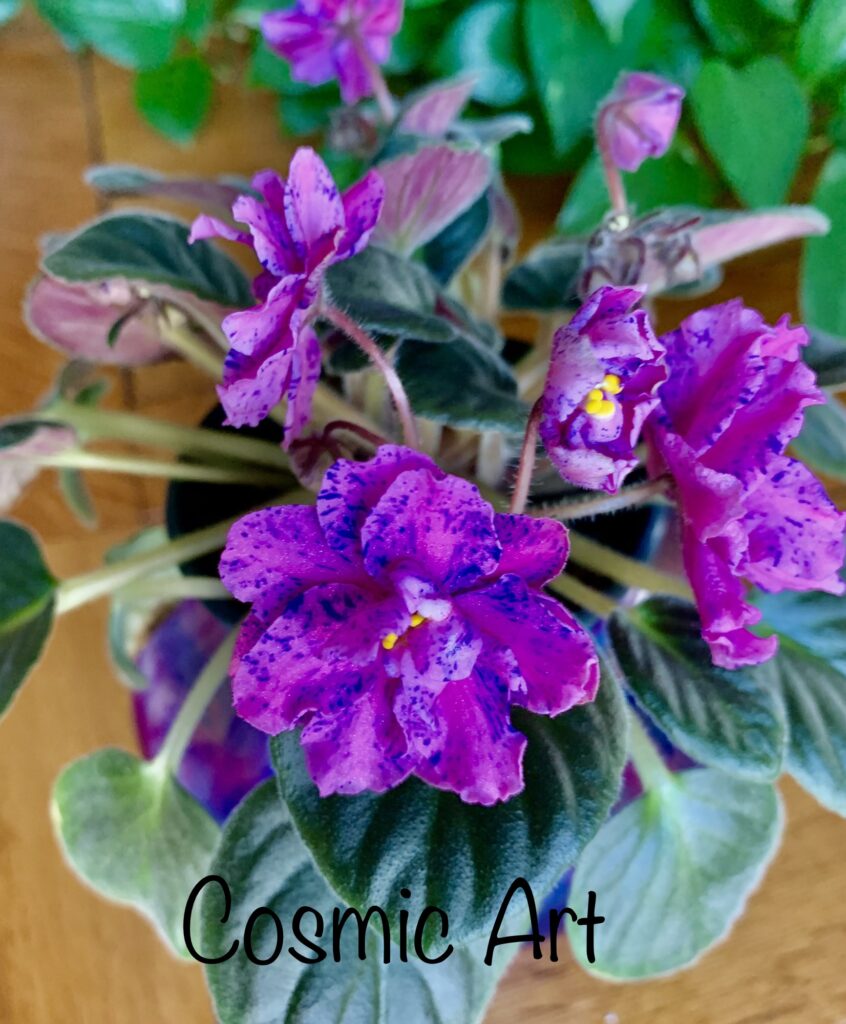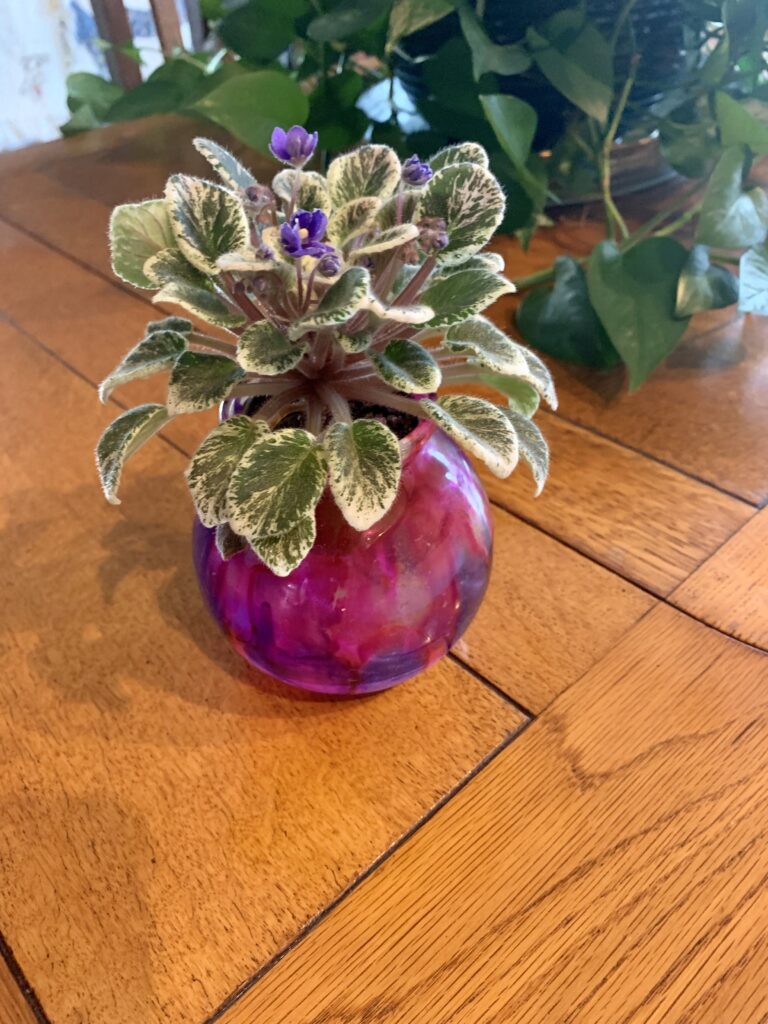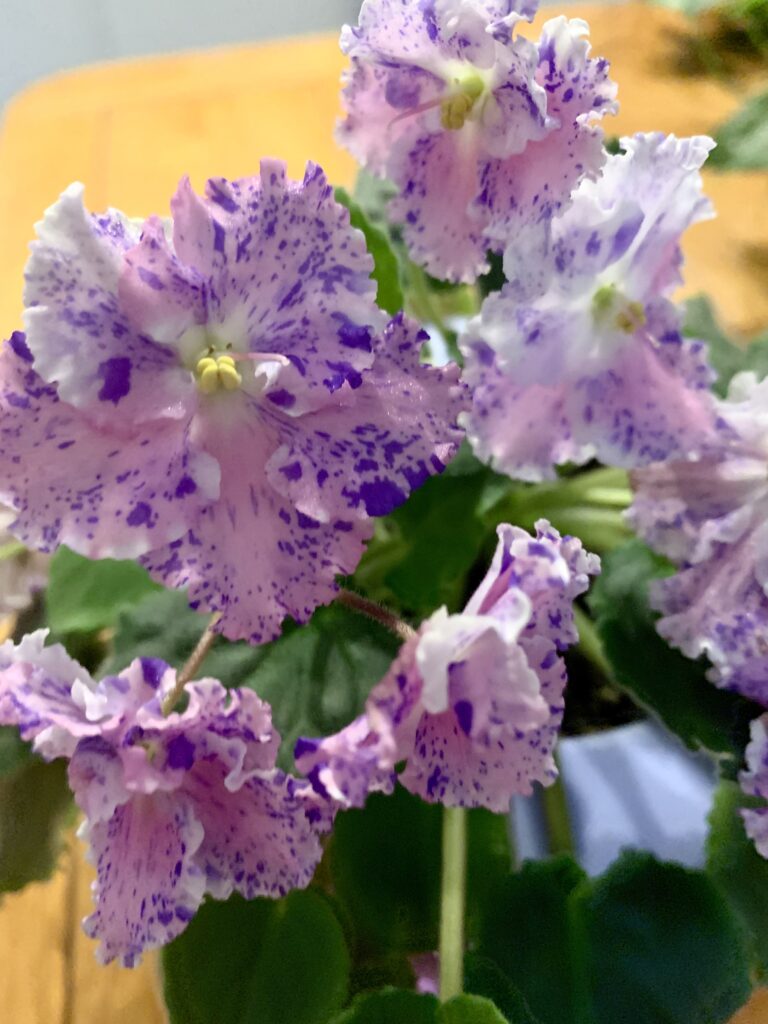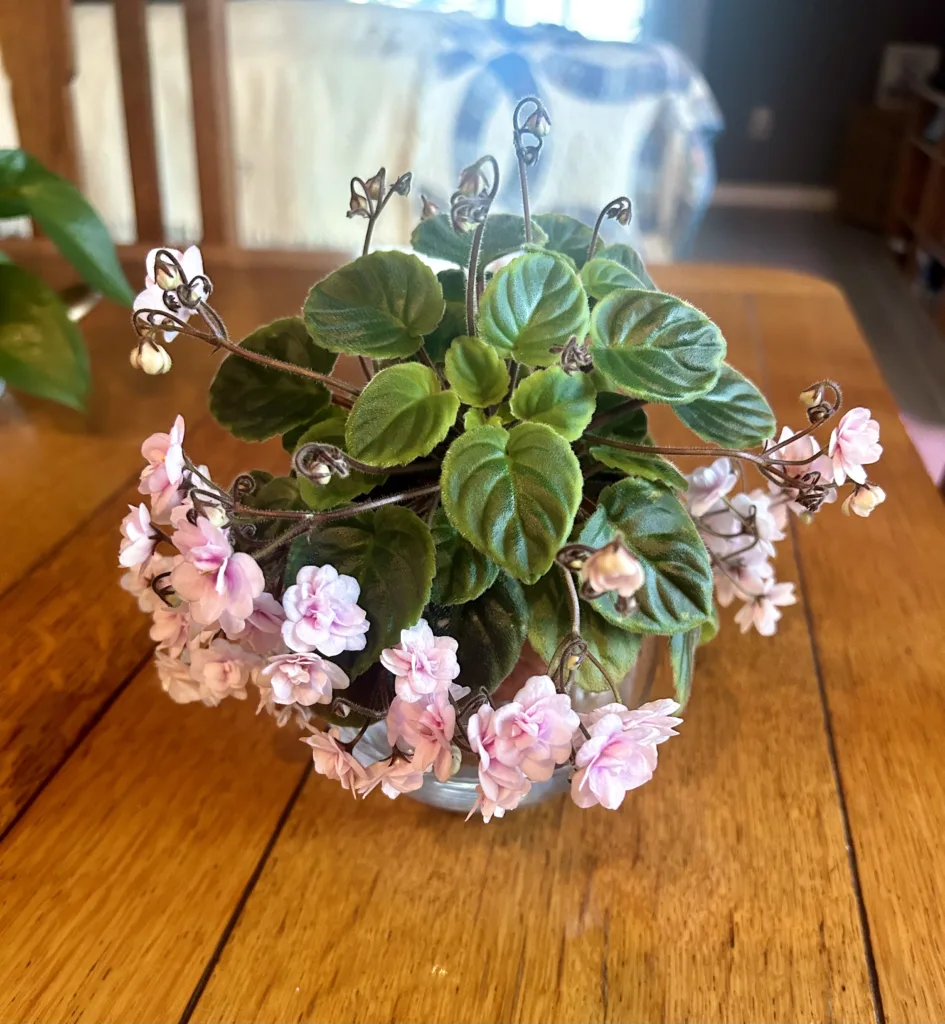
African violets are known for their velvety leaves and beautiful blooms. These charming houseplants grow well indoors, but they do need repotting every so often to stay healthy. Repotting helps refresh the soil, promote better root growth, and keep your plant blooming year-round. In this guide, you’ll learn when and how to repot African violets, the best pot size and soil, and how to care for your plant afterward. All the pictures on this page are just a few of my AV collection-hope you enjoy!
How Often Should You Repot African Violets?
You should repot African violets every 6 to 12 months. They don’t like to be root-bound, and old soil loses nutrients over time. If your plant starts growing slowly, the leaves look crowded, or the soil dries out too fast or stays wet too long, it’s time to repot. Even if your plant looks fine, repotting once a year keeps it in top shape.
Choosing the Right Pot Size

African violets do best in small pots. A good rule is to use a pot that’s about one-third the diameter of the plant’s leaf span. For example, if your plant is 9 inches wide, choose a 3-inch pot. A pot that’s too large holds extra moisture and can lead to root rot. Don’t size up too much when repotting. Instead, move up just one pot size if needed. This keeps your violet compact and encourages more blooms.
Picking the Right Pot Type
There are several types of pots you can use for African violets. Each has its pros and cons, and your watering routine can help you choose the best one.
Ceramic African violet pots come in two pieces: an inner unglazed pot that holds the plant and an outer glazed pot that holds water. This setup uses capillary action to wick water into the soil slowly. It’s a great choice if you want consistent moisture without daily watering.
Self-watering or water-wicking pots also have a reservoir at the bottom. A wick, usually made of cotton or nylon, pulls water from the reservoir up into the soil. These pots are perfect if you travel often or forget to water on schedule. For more in depth post on creating your own DIY water-wicking pots just click here.
Plain plastic or clay pots work well too. If you use these, make sure they have good drainage holes. With these pots, you’ll need to water from the top or bottom, depending on your preference.
Top Watering vs. Bottom Watering
African violets prefer bottom watering, especially when planted in regular pots. Set the pot in a shallow tray of water for about 20 minutes, letting the soil soak up what it needs. This method keeps the leaves dry, which helps prevent rot and disease.
If you prefer top watering, pour lukewarm water onto the soil gently. Avoid getting the leaves wet. Always let the pot drain completely, and never let your plant sit in standing water.
Choosing the Right Soil
African violets need light, airy soil that drains well and holds just enough moisture. You can buy pre-mixed African violet soil at most garden centers. These mixes are usually made with peat moss, perlite, and vermiculite in the right balance.
If you want to mix your own soil, I use the following blend-that my Father and Grandmother both used:
- 50% peat moss
- 25% perlite
- 25% vermiculite
This homemade mix gives your African violet everything it needs—good drainage, proper aeration, and moisture retention. Avoid regular potting soil, as it’s too heavy and can smother the roots.
How to Repot an African Violet
Start by choosing your new pot and preparing your soil. Make sure everything is clean to avoid disease. Gently remove the violet from its current pot by tipping it sideways and tapping the sides. Support the plant at the base to avoid damaging the leaves.
Next, check the roots. Trim away any dead or mushy roots with clean scissors. If the lower leaves have formed a “neck” or bare stem, remove a few of the bottom leaves. Then gently scrape off the top layer of old soil and a bit from the root ball.
Place some fresh soil in the bottom of the new pot. Center the plant and add more soil around the sides, pressing lightly to keep it stable. The crown of the plant should sit just above the soil line. Water lightly from the bottom to help settle the soil and remove air pockets.
When to Repot Baby Plants or Suckers

African violets often grow suckers—small offshoots that crowd the main plant. If you see these, remove them with your fingers or a clean knife before repotting. Removing suckers lets the main plant grow better and bloom more often.
If you want to grow new plants, you can pot the suckers separately using the same method and soil mix. Baby plants will grow well if you give them warmth, bright light, and bottom watering.
Watering After Repotting
After repotting, your violet will need some time to adjust. Water it lightly and keep it in a warm, bright spot out of direct sun. Don’t soak the soil or fertilize right away. Let the roots settle in for about two weeks before returning to a normal care routine.
Water when the top inch of soil feels dry. African violets prefer steady moisture but not soggy soil. Always check with your finger or use a moisture meter to avoid overwatering.
Fertilizing Your Repotted Violet
About two weeks after repotting, start feeding your plant again. African violets bloom best with regular, balanced fertilizer. One of the best and my personal choice is Schultz African Violet Plus Plant Food (8-14-9). It’s easy to use and helps support healthy blooms and foliage.
Mix a few drops into water and apply every time you water, or use it once a week depending on your schedule. This gentle fertilizer won’t burn the roots and gives your plant all the nutrients it needs.
Signs Your African Violet Needs Repotting
Even with regular care, your African violet will tell you when it’s ready for a new pot. Look for these signs:
- Roots are growing out of the bottom
- Soil dries too quickly or stays wet
- Leaves crowd or grow upward
- Growth has slowed or blooms have stopped
- A long “neck” has formed under the leaves
If you notice one or more of these, plan to repot soon.
Best Time of Year to Repot
You can repot African violets any time of year, but spring and summer work best. During this time, the plant grows more actively and recovers faster from transplant shock. Avoid repotting during winter unless absolutely necessary, as growth slows and recovery takes longer.
Final Thoughts

Repotting African violets doesn’t have to be hard. Once you learn when to repot, how to choose the right pot and soil, and how to water and feed your plant, you’ll see stronger growth and more blooms. Use the right tools, stick to a routine, and pay attention to what your plant needs.
Whether you grow just one African violet or a dozen, repotting is key to long-term success. With a fresh start in the right pot and soil, your plant will reward you with healthy leaves and colorful flowers year-round.
Please be sure to check out my Gardening Blog Post Page for more tips on all types of gardening. Including Seed Saving, Seed Starting, Orchids, Water Gardening, Coldframe Gardening, Indoor Bulb Gardening, Hydroponics, Container Gardening, Mums, Herbs, African Violets, planting Bulbs, Flower Gardening, Vegetable and Fruit Gardening, Indoor Houseplants of all kinds, Cactus, Succulents, Hanging plants, Deer resistant plants and even Bird, Bee, Butterfly and Hummingbird Gardens!
